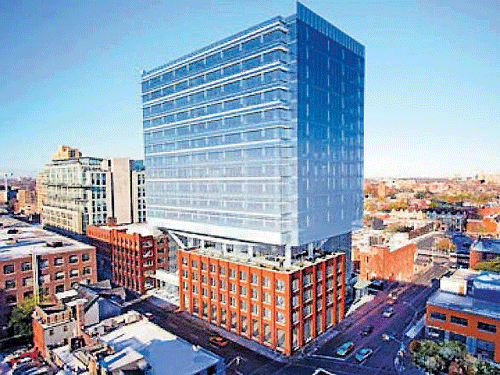In the ever-changing dynamics of today’s age, the world has often faced challenges
involving the incorporation of new design in existing historical constructions. The latest is the challenge faced by Queen Richmond Centre, a four-storey, century-old building in Toronto, Canada. The question here is: how to suspend a 13-storey office building atop a four-storey historic masonry building in a tight site?
The obvious solution of using conventional columns would not work since a large size and number of columns would have been required. What consulting engineer Stephenson
Engineering Ltd and Sweeny Sterling Finlayson & Co Architects Inc decided to do was to use a series of 70-foot-tall “delta frames”, each comprised of one-metre-diameter tubular steel columns shooting up through the new development’s atrium (already a part of the four-storey structure) to support the new tower.
With high lateral stability, the tubes that make up the delta frames are positioned at angles to intersect each other at midpoint for improved gravity and lateral force resistance. The key to the strength of these steel tubular columns is that they will be filled with concrete to increase load-bearing capacity. The success of the design depends on the 35,000-pound cast steel nodes, which tie each delta frame together at its intersection.
Connecting the steel nodes to columns where they intersect will be done in the field through a combination bearing and partial penetration weld. The legs or columns will be supported in space in precise locations before the nodes are welded in place. The cast steel nodes provide for a happy medium of meeting both the struc-tural and architectural requirements.
Moreover, the cast steel nodes add to the architectural elegance of the steel delta frames.Carlos de Oliveira, president and principal structural engineer, Cast Connex Corporation, designer and supplier of the cast steel nodes for the project, feels that steel casting has an innovative way of making structural steel do the seemingly impossible.
Indeed, it’s an engineering feat that needs a structural engineer in a design-assist capacity on the project. But aesthetically, while normal plates would stand out, the cast steel nodes blend into the delta frame and allow for a more compact connection.
The Queen Richmond Centre West development will be constructed in two phases.
The first phase, a retrofit of the historic building, is underway. This will, indeed, be an engineering marvel and beauty to behold.
